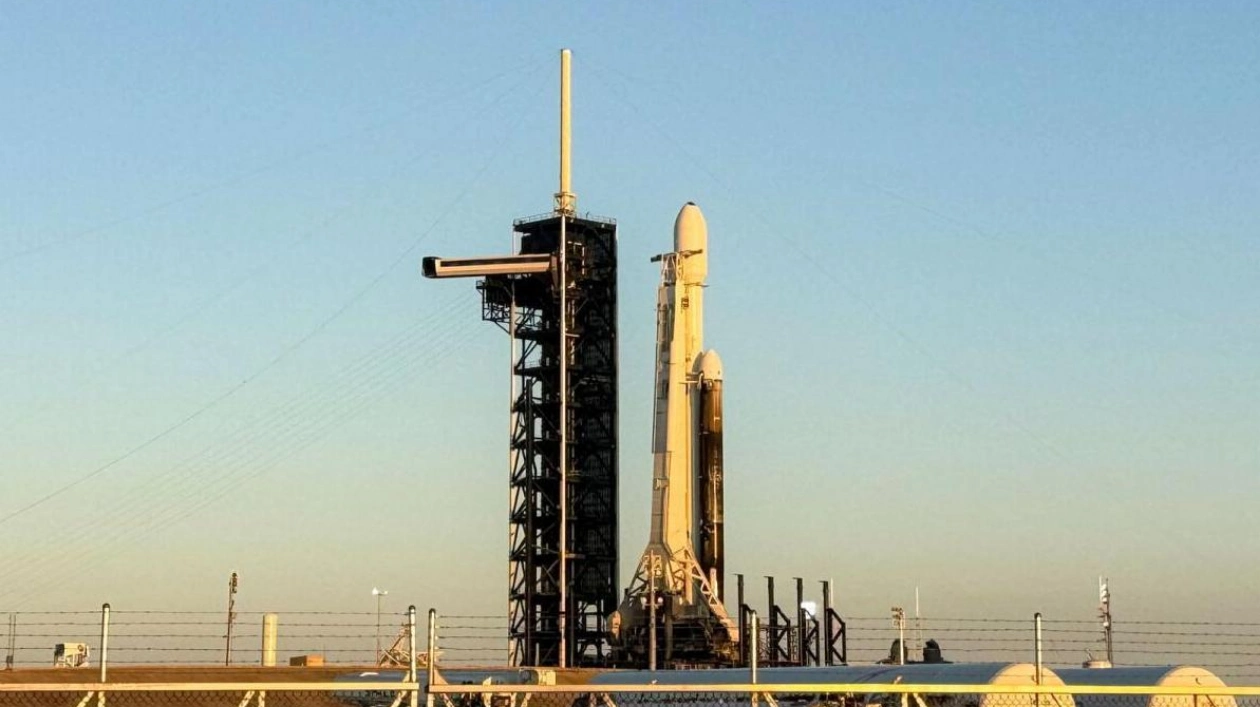The SpaceX Falcon Heavy rocket, carrying the Clipper spacecraft, was positioned on launch pad 39A at the Kennedy Space Center in Florida prior to its launch on October 14, 2024. Photos: AFP
NASA successfully launched a spacecraft from Florida on Monday, aiming to investigate whether Jupiter's moon Europa possesses conditions conducive to supporting life, with a particular focus on the extensive subsurface ocean thought to exist beneath its thick icy exterior. The US space agency's Europa Clipper spacecraft took off from the Kennedy Space Center in Cape Canaveral atop a SpaceX Falcon Heavy rocket under clear skies. The robotic, solar-powered probe is scheduled to enter Jupiter's orbit in 2030, following a 5-1/2-year journey covering approximately 1.8 billion miles (2.9 billion km). The launch, originally planned for last week, was postponed due to Hurricane Milton. This marks the largest spacecraft NASA has constructed for a planetary mission, measuring about 100 feet (30.5 meters) in length and approximately 58 feet (17.6 meters) in width when its antennas and solar arrays are fully extended—larger than a basketball court—and weighing around 13,000 pounds (6,000 kg).
The Icon Heavy rocket, with the Europa Clipper spacecraft onboard, lifted off from Launch Complex 39A at NASA's Kennedy Space Center in Cape Canaveral on October 14, 2024.
Although Europa, the fourth-largest of Jupiter's 95 officially recognized moons, is only a quarter of Earth's diameter, its vast, salty liquid water ocean could contain twice the volume of water found in Earth's oceans. Earth's oceans are believed to be the cradle of life on our planet. With a diameter of roughly 1,940 miles (3,100 km), Europa is approximately 90% the size of our moon and has been considered a potential habitat for extraterrestrial life within our solar system. Its icy shell is estimated to be 10-15 miles (15-25 km) thick, overlaying an ocean 40-100 miles (60-150 km) deep.
NASA Associate Administrator Jim Free highlighted during a prelaunch briefing on Sunday that Europa represents one of the most promising environments for potential habitability beyond Earth in our solar system, although he emphasized that this mission is not aimed at discovering actual living organisms. 'What we uncover on Europa,' Free stated, 'will have profound implications for the study of astrobiology and our understanding of our place in the universe.' 'Scientists believe Europa has the necessary conditions beneath its icy surface to support life. These conditions include water, energy, chemistry, and stability,' explained Sandra Connelly, deputy associate administrator of NASA's science mission directorate.
Key mission objectives include measuring the internal ocean and the ice layer above it, mapping the moon's surface composition, and searching for water vapor plumes that may be emanating from Europa's icy crust. The plan involves Europa Clipper conducting 49 close flybys of Europa starting in 2031 over a three-year period, approaching as close as 16 miles (25 kilometers) to the moon's surface. Operating in the intense radiation environment around Jupiter, the largest planet in our solar system, poses a significant challenge. Jupiter's magnetic field, about 20,000 times stronger than Earth's, spins rapidly, capturing and accelerating charged particles and generating radiation that could damage spacecraft. To safeguard its sensitive electronics, NASA constructed a radiation-proof vault made of titanium and aluminum within the Europa Clipper.
'One of the primary challenges for the Europa Clipper mission is designing a spacecraft robust enough to endure the relentless radiation from Jupiter while also being sensitive enough to collect the measurements required to explore Europa's environment,' Connelly noted. NASA confirmed that Europa Clipper is equipped with over 6,060 pounds (2,750 kg) of propellant to propel it to Jupiter. For the launch, the spacecraft was housed within the protective nose cone atop the rocket. Instead of a direct route to Jupiter, the spacecraft will fly by Mars and then Earth, leveraging the gravity of each planet to boost its momentum, akin to a slingshot. Its expansive solar arrays, folded for the launch, will harness sunlight to power the spacecraft's nine scientific instruments, as well as its electronics and other subsystems.






